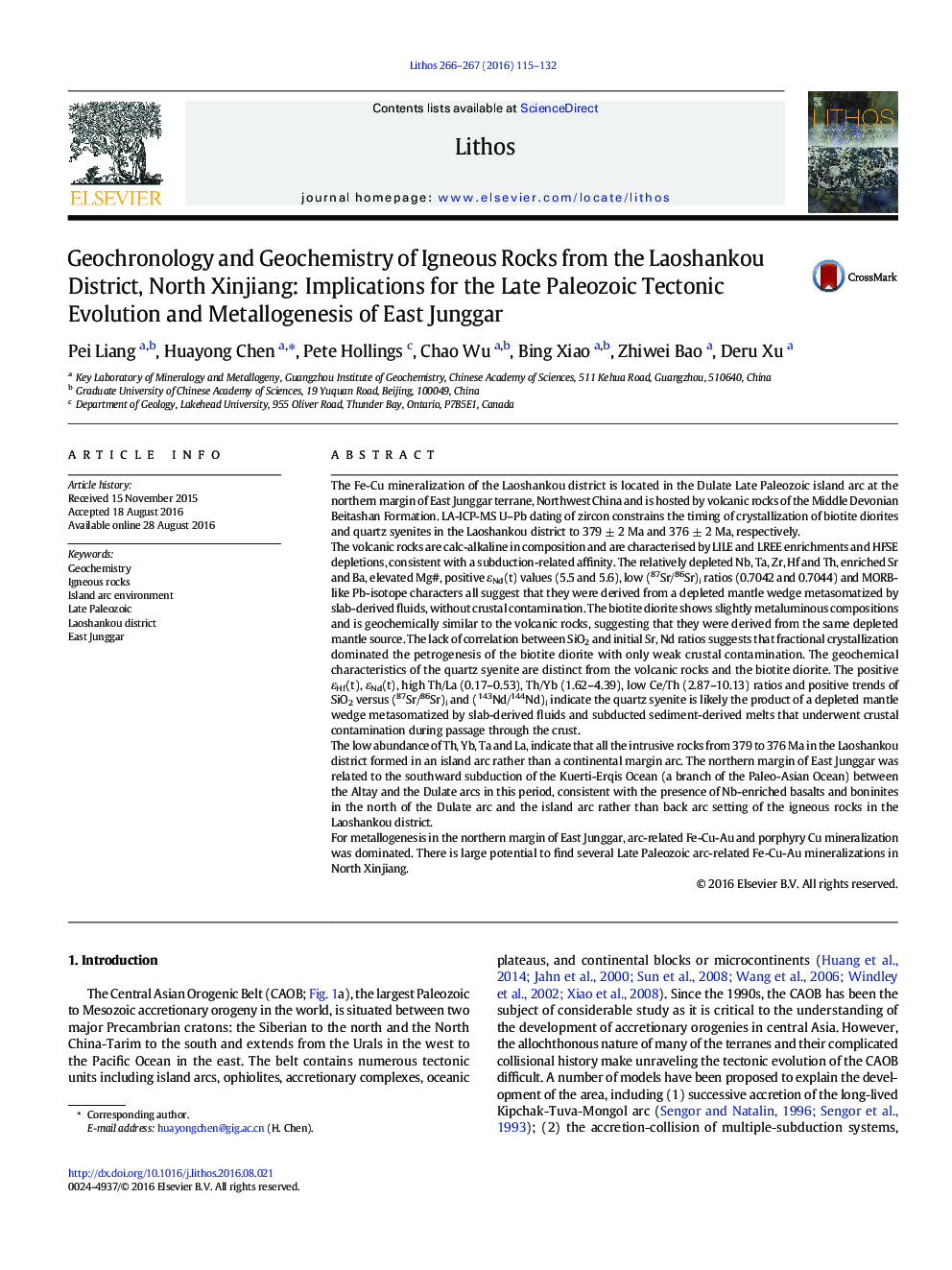| کد مقاله | کد نشریه | سال انتشار | مقاله انگلیسی | نسخه تمام متن |
|---|---|---|---|---|
| 4715453 | 1638638 | 2016 | 18 صفحه PDF | دانلود رایگان |

• The Laoshankou igneous rocks were emplaced from 381 Ma to 376 Ma.
• These igneous rocks were derived from the same depleted magma source.
• During the Late Paleozoic, the East Junggar was located in an island arc environment.
• This arc was formed by the southward subduction of the Kuerti-Erqis oceanic plate.
• A potential Late Paleozoic Fe-Cu-Au metallogenic belt existed in the East Junggar.
The Fe-Cu mineralization of the Laoshankou district is located in the Dulate Late Paleozoic island arc at the northern margin of East Junggar terrane, Northwest China and is hosted by volcanic rocks of the Middle Devonian Beitashan Formation. LA-ICP-MS U–Pb dating of zircon constrains the timing of crystallization of biotite diorites and quartz syenites in the Laoshankou district to 379 ± 2 Ma and 376 ± 2 Ma, respectively.The volcanic rocks are calc-alkaline in composition and are characterised by LILE and LREE enrichments and HFSE depletions, consistent with a subduction-related affinity. The relatively depleted Nb, Ta, Zr, Hf and Th, enriched Sr and Ba, elevated Mg#, positive εNd(t) values (5.5 and 5.6), low (87Sr/86Sr)i ratios (0.7042 and 0.7044) and MORB-like Pb-isotope characters all suggest that they were derived from a depleted mantle wedge metasomatized by slab-derived fluids, without crustal contamination. The biotite diorite shows slightly metaluminous compositions and is geochemically similar to the volcanic rocks, suggesting that they were derived from the same depleted mantle source. The lack of correlation between SiO2 and initial Sr, Nd ratios suggests that fractional crystallization dominated the petrogenesis of the biotite diorite with only weak crustal contamination. The geochemical characteristics of the quartz syenite are distinct from the volcanic rocks and the biotite diorite. The positive εHf(t), εNd(t), high Th/La (0.17–0.53), Th/Yb (1.62–4.39), low Ce/Th (2.87–10.13) ratios and positive trends of SiO2 versus (87Sr/86Sr)i and (143Nd/144Nd)i indicate the quartz syenite is likely the product of a depleted mantle wedge metasomatized by slab-derived fluids and subducted sediment-derived melts that underwent crustal contamination during passage through the crust.The low abundance of Th, Yb, Ta and La, indicate that all the intrusive rocks from 379 to 376 Ma in the Laoshankou district formed in an island arc rather than a continental margin arc. The northern margin of East Junggar was related to the southward subduction of the Kuerti-Erqis Ocean (a branch of the Paleo-Asian Ocean) between the Altay and the Dulate arcs in this period, consistent with the presence of Nb-enriched basalts and boninites in the north of the Dulate arc and the island arc rather than back arc setting of the igneous rocks in the Laoshankou district.For metallogenesis in the northern margin of East Junggar, arc-related Fe-Cu-Au and porphyry Cu mineralization was dominated. There is large potential to find several Late Paleozoic arc-related Fe-Cu-Au mineralizations in North Xinjiang.
Journal: Lithos - Volumes 266–267, December 2016, Pages 115–132